Updated 6/9/21
For the past year or so those of us working in the marketing industry have been hearing reports of big sweeping changes that would happen to the advertising ecosystem as a result of Apple making changes to what they allow and don’t allow advertisers to do on iOS devices. Know as IDFA, the way advertisers were able to track actions taken by the user on various websites and within native apps on iOS devices enabled them to run fairly granular ad targeting. The chatter in the industry was that Apple at some point in the future would cut off this tracking capability, ensuring that user privacy was protected. Apple did in fact roll out significant privacy updates in iOS 14.5, including now the ability for users to decide if they want to be tracked by 3rd party apps or not.
Of course, the major brands, advertisers, and platforms (namely, Facebook) were not thrilled as they learned more over subsequent months and leading up to the date when changes were to take place with the rollout of iOS 14.5. What the changes impact is the ability to do granular targeting that traditionally would be followed up with through remarketing and other deeply targeted – and personalized – ad campaigns. The majority of this tracking is now gone, leaving advertisers with a lot less data to go on when running campaigns. Facebook lobbied very hard against these changes, going so far as to take out full page advertisements in newspapers, discuss live on TV, and run all sorts of in product campaigns to educate advertisers on the potential impact of the changes.
Fast forward to May 2021 – Apple won, Facebook lost.
When I originally predicted what percent of users would be OK with tracking being left on I thought we’d see 20-30% of users opt in. The actual metric that we’re seeing from reporting company Flurry is way, way less than that. Here are some stats:


This opt-in rate is nearly 5-times lower than I thought it would be – and I thought I was being conservative. Talk about being wrong!
Google is now also joining the opt-out party
On 6/9/2021 I came across this article saying that Android is following in Apple’s footsteps, and by the end of 2021 tracking will now be optional.
So while the industry reels from the impact and fallout this will have – the reality is that for marketers and brands moving forward, ad campaign performance for paid acquisition is likely going to rise, and may never come back down.
If the global opt-in numbers begin to resemble the US based numbers, brands are going to have to consider how to allocate their performance marketing budgets knowing that a huge chunk of what they likely got very good at – highly targeted ad campaigns – has just gotten much, much less effective. Put simply – we’ll spend more to get worse results.
What does this mean for paid marketers and brands alike? What are the short and long term implications of this type of industry changing shift?
Short term impacts
We don’t know for sure, obviously, but my prediction is that short term we’re going to see a bit of a panic mode set in around advertising – specifically in the paid marketing space (think Facebook ads). At Growth University we get exposure to a ton of different companies, and we’re hearing and seeing a pull back in spend short term from paid social, and marketers are not sure where to reallocate that budget.
Long term impacts
Longer term it’s unclear what will happen, but I believe Apple will become a larger player in the ad space (watch as they continue to roll out new advertising opportunities for within the Apple ecosystem) and I also believe that paid social and all of it’s richness around tracking is forever changed. Add Google and Android to the mix now, and we’re looking at a disrupted industry.
Now, this isn’t to say one can’t or won’t be successful leveraging paid social for marketing. I still believe the major ad platforms like Facebook will still create a huge amount of opportunity for brands and marketers to connect with users – it’s just the type of opportunities we once had have evaporated.
This is not the end of paid advertising, it’s just a change
I also won’t go as far as saying this is the final nail in the advertising model coffin – there are endless ways that the rise of AR and VR coupled with location centric hyper geo targeting will provide advertisers with all sorts of great ways to reach potential customers. But it does make one question how much focus should be spent on top of funnel channels where some level of granular targeting is still happening versus how much focus should happen post click.
Want to learn more about how to account for iOS 14.5? Become a Growth University member for $1 for 1 week and take our Paid Acquisition: Facebook Advertising Program – designed to help you succeed in your Facebook strategy in this privacy first world.
Where the new opportunity lies
Which brings me to the point of this post. I believe we’re entering the era of holistic marketing. We’re at a time where the fastest growing companies will realize that they need to align marketing and product development much more closely, and ensure that value gets created for the user or potential buyer at each stage of the buyer journey. It means that the days of simply throwing budget at a channel and knowing that the channel will scale infinitely for a long period of time before becoming inefficient are likely over.
Now, that’s not to say that all channels are going to become harder to market in. But it’s highly likely that as protecting user privacy becomes more of a core focus of the largest tech companies (and governments….think GDPR) the harder it’s going to be for marketers to directly target customers – and more guesswork will be involved in targeting.
While this is concerning for folks who make a living running performance marketing campaigns – and certainly will impact the [mostly] small businesses who rely on detailed tracking in channels like Facebook to keep their customer acquisition costs low enough to sustain their business…and it’s always small businesses that the big tech ad platforms seem to hurt the most, first – it actually opens up an opportunity for companies who think holistically about marketing to shine.
If the ability to target granular sets of users becomes harder across the board, the normalization of the strategy means that advantages in other areas of growth could have an outsized impact on startup metrics.
Take for example the initial landing page or website experience of a user who clicks an ad on Facebook under these new guidelines. The ad platform likely doesn’t know as much about the user and their historical actions anymore, but their machine learning will certainly help steer them to the websites where it thinks a conversion may happen. The importance now of a clean UX, solid value prop, clear messaging, and overall great customer experience all of a sudden becomes a lot more important.
Post-click experience will become even more critical
This is what I refer to as the post-click experience. All of the actions users take after they click the ad, or otherwise hear about your product. The opportunity to now compete against brands who might be able to outspend you, but who can no longer our target you, means you now have a more level playing field. This is a huge, huge opportunity for startups to take advantage of.
Which brings me to the point of aligning product and marketing. Teams who work together on the post-click experience – everything from jointly owning EPAG (end point acquisition goal) metrics to co-owning the onboarding experience means that faster feedback loops between the user and the company are possible. If marketing and product are joined and aligned, they will figure out the best ways to engage and add value to the user who may not have as much context about the brand as they would have in prior scenarios where targeting is better. After all, if the marketer doesn’t know that the user has seen or visited the brand before because they can’t track them, they can’t plan for an activation pathway that’s customized based on buyer journey stage.
So what does this mean? It means that the initial experience the user sees is more important then ever. The messaging has to be stronger than ever. The conversion pathways have to make more sense than ever. And the marketer – the marketer needs to think much more holistically about where and how they’ll acquire the customer, and once they do – they’ll need to ensure that the product team has put the best aspects of the product forward to show case to the user.
Now, much of this post could be made less revenue if, as Ben Evans has written about, Apple is eying a major move to put them deeper into the advertising space. If that happens, Apple becomes the new Facebook to some degree, and while the medium will shift, the strategies will be more similar to what we’ve become used to – targeting users based on activity. It’ll just so happen to only be applicable to things happening within the Apple ecosystem (including what’s happening on-device).
It also means that channels that perhaps aren’t as viable today will become more viable tomorrow. It means that capturing 1st party data – an email address for example – will be exponentially more valuable than it even is today, since having an email means you can directly market to the user.
So while this is clearly a lot of change and a lot to think about, I’m extremely excited about what’s coming next. I think marketers will become savvy in areas they’ve not had to focus on as much historically (the post-click experience), product teams will be closer to the actions of marketing, users will be more in control of their privacy, and the overall experience and value added to enhance the buyer journey will go up.
To the future!
If you like this post, please sign up for our newsletter here. And view our growth & marketing programs here.

Craig Zingerline is a 6 time founder who has helped dozens of companies scale their growth. Prior to Velocity Growth, Craig was the Chief Product Officer @ Sandboxx, Head of Growth at Upside Travel, CEO of Votion, Head of Growth at Red Tricycle, and VP at New Signature. In addition to in-house roles, Craig has advised and consulted with dozens of high growth startups (4 exits). He’s an award winning product strategist who has mentored hundreds of founders on growth, marketing, and product management.






